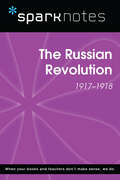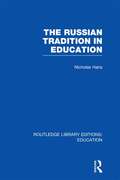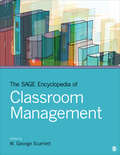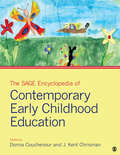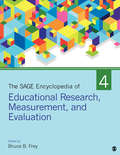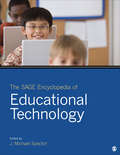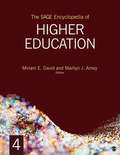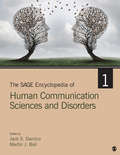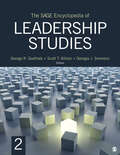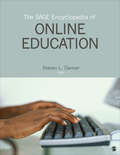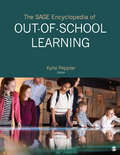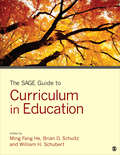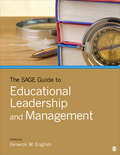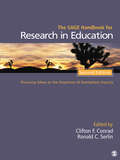- Table View
- List View
The Russian Revolution (SparkNotes History Notes)
by SparkNotesThe Russian Revolution (1917-1918) (SparkNotes History Note) Making the reading experience fun! SparkNotes History Guides help students strengthen their grasp of history by focusing on individual eras or episodes in U.S. or world history. Breaking history up into digestible lessons, the History Guides make it easier for students to see how events, figures, movements, and trends interrelate. SparkNotes History Guides are perfect for high school and college history classes, for students studying for History AP Test or SAT Subject Tests, and simply as general reference tools.Each note contains a general overview of historical context, a concise summary of events, lists of key people and terms, in-depth summary and analysis with timelines, study questions and suggested essay topics, and a 50-question review quiz.
The Russian Tradition in Education (Routledge Library Editions: Education)
by Nicholas HansThis volume describes the Russian tradition in education and in particular the dominant role of Russian nationality. The whole history of Russian education is covered from Peter the Great to Khruschev.
The SAGE Encyclopedia of Classroom Management
by W. George ScarlettA teacher’s ability to manage the classroom strongly influences the quality of teaching and learning that can be accomplished. Among the most pressing concerns for inexperienced teachers is classroom management, a concern of equal importance to the general public in light of behavior problems and breakdowns in discipline that grab newspaper headlines. But classroom management is not just about problems and what to do when things go wrong and chaos erupts. It’s about how to run a classroom so as to elicit the best from even the most courteous group of students. An array of skills is needed to produce such a learning environment. The SAGE Encyclopedia of Classroom Management raises issues and introduces evidence-based, real-world strategies for creating and maintaining well-managed classrooms where learning thrives. Students studying to become teachers will need to develop their own classroom management strategies consistent with their own philosophies of teaching and learning. This work aims to open their eyes to the range of issues and the array of skills they might integrate into their unique teaching styles. Key Features: 325 signed entries organized in A-to-Z fashion across two volumes Reader′s Guide grouping related entries thematically References/Further Readings and Cross-References sections Chronology in the back matter Resource Guide in the appendix This encyclopedia is an excellent scholarly source for students who are pursuing a degree or position in the field of education. The SAGE Encyclopedia of Classroom Management is an ideal source for all academic and public libraries.
The SAGE Encyclopedia of Classroom Management
by W. George ScarlettA teacher’s ability to manage the classroom strongly influences the quality of teaching and learning that can be accomplished. Among the most pressing concerns for inexperienced teachers is classroom management, a concern of equal importance to the general public in light of behavior problems and breakdowns in discipline that grab newspaper headlines. But classroom management is not just about problems and what to do when things go wrong and chaos erupts. It’s about how to run a classroom so as to elicit the best from even the most courteous group of students. An array of skills is needed to produce such a learning environment. The SAGE Encyclopedia of Classroom Management raises issues and introduces evidence-based, real-world strategies for creating and maintaining well-managed classrooms where learning thrives. Students studying to become teachers will need to develop their own classroom management strategies consistent with their own philosophies of teaching and learning. This work aims to open their eyes to the range of issues and the array of skills they might integrate into their unique teaching styles. Key Features: 325 signed entries organized in A-to-Z fashion across two volumes Reader′s Guide grouping related entries thematically References/Further Readings and Cross-References sections Chronology in the back matter Resource Guide in the appendix This encyclopedia is an excellent scholarly source for students who are pursuing a degree or position in the field of education. The SAGE Encyclopedia of Classroom Management is an ideal source for all academic and public libraries.
The SAGE Encyclopedia of Contemporary Early Childhood Education
by J. Kent Chrisman Donna CouchenourThe general public often views early childhood education as either simply "babysitting" or as preparation for later learning. Of course, both viewpoints are simplistic. Deep understanding of child development, best educational practices based on development, emergent curriculum, cultural competence and applications of family systems are necessary for high-quality early education. Highly effective early childhood education is rare in that it requires collaboration and transitions among a variety of systems for children from birth through eight years of age. The SAGE Encyclopedia of Contemporary Early Childhood Education presents in three comprehensive volumes advanced research, accurate practical applications of research, historical foundations and key facts from the field of contemporary early childhood education. Through approximately 425 entries, this work includes all areas of child development – physical, cognitive, language, social, emotional, aesthetic – as well as comprehensive review of best educational practices with young children, effective preparation for early childhood professionals and policy making practices, and addresses such questions as: · How is the field of early childhood education defined? · What are the roots of this field of study? · How is the history of early childhood education similar to yet different from the study of public education? · What are the major influences on understandings of best practices in early childhood education?
The SAGE Encyclopedia of Contemporary Early Childhood Education
by J. Kent Chrisman Donna CouchenourThe general public often views early childhood education as either simply "babysitting" or as preparation for later learning. Of course, both viewpoints are simplistic. Deep understanding of child development, best educational practices based on development, emergent curriculum, cultural competence and applications of family systems are necessary for high-quality early education. Highly effective early childhood education is rare in that it requires collaboration and transitions among a variety of systems for children from birth through eight years of age. The SAGE Encyclopedia of Contemporary Early Childhood Education presents in three comprehensive volumes advanced research, accurate practical applications of research, historical foundations and key facts from the field of contemporary early childhood education. Through approximately 425 entries, this work includes all areas of child development – physical, cognitive, language, social, emotional, aesthetic – as well as comprehensive review of best educational practices with young children, effective preparation for early childhood professionals and policy making practices, and addresses such questions as: · How is the field of early childhood education defined? · What are the roots of this field of study? · How is the history of early childhood education similar to yet different from the study of public education? · What are the major influences on understandings of best practices in early childhood education?
The SAGE Encyclopedia of Educational Research, Measurement, and Evaluation
by Bruce B. FreyIn an era of curricular changes and experiments and high-stakes testing, educational measurement and evaluation is more important than ever. In addition to expected entries covering the basics of traditional theories and methods, other entries discuss important sociopolitical issues and trends influencing the future of that research and practice. Textbooks, handbooks, monographs and other publications focus on various aspects of educational research, measurement and evaluation, but to date, there exists no major reference guide for students new to the field. This comprehensive work fills that gap, covering traditional areas while pointing the way to future developments. Features: Nearly 700 signed entries are contained in an authoritative work spanning four volumes and available in choice of electronic and/or print formats. Although organized A-to-Z, front matter includes a Reader’s Guide grouping entries thematically to help students interested in a specific aspect of education research, measurement, and evaluation to more easily locate directly related entries. (For instance, sample themes include Data, Evaluation, Measurement Concepts & Issues, Research, Sociopolitical Issues, Standards.) Back matter includes a Chronology of the development of the field; a Resource Guide to classic books, journals, and associations; and a detailed Index. Entries conclude with References/Further Readings and Cross References to related entries. The Index, Reader’s Guide themes, and Cross References will combine to provide robust search-and-browse in the e-version.
The SAGE Encyclopedia of Educational Research, Measurement, and Evaluation
by Bruce B. FreyIn an era of curricular changes and experiments and high-stakes testing, educational measurement and evaluation is more important than ever. In addition to expected entries covering the basics of traditional theories and methods, other entries discuss important sociopolitical issues and trends influencing the future of that research and practice. Textbooks, handbooks, monographs and other publications focus on various aspects of educational research, measurement and evaluation, but to date, there exists no major reference guide for students new to the field. This comprehensive work fills that gap, covering traditional areas while pointing the way to future developments. Features: Nearly 700 signed entries are contained in an authoritative work spanning four volumes and available in choice of electronic and/or print formats. Although organized A-to-Z, front matter includes a Reader’s Guide grouping entries thematically to help students interested in a specific aspect of education research, measurement, and evaluation to more easily locate directly related entries. (For instance, sample themes include Data, Evaluation, Measurement Concepts & Issues, Research, Sociopolitical Issues, Standards.) Back matter includes a Chronology of the development of the field; a Resource Guide to classic books, journals, and associations; and a detailed Index. Entries conclude with References/Further Readings and Cross References to related entries. The Index, Reader’s Guide themes, and Cross References will combine to provide robust search-and-browse in the e-version.
The SAGE Encyclopedia of Educational Technology
by Professor J. Michael SpectorThe SAGE Encyclopedia of Educational Technology examines information on leveraging the power of technology to support teaching and learning. While using innovative technology to educate individuals is certainly not a new topic, how it is approached, adapted, and used toward the services of achieving real gains in student performance is extremely pertinent. This two-volume encyclopedia explores such issues, focusing on core topics and issues that will retain relevance in the face of perpetually evolving devices, services, and specific techniques. As technology evolves and becomes even more low-cost, easy-to-use, and more accessible, the education sector will evolve alongside it. For instance, issues surrounding reasoning behind how one study has shown students retain information better in traditional print formats are a topic explored within the pages of this new encyclopedia. Features: A collection of 300-350 entries are organized in A-to-Z fashion in 2 volumes available in a choice of print or electronic formats. Entries, authored by key figures in the field, conclude with cross references and further readings. A detailed index, the Reader’s Guide themes, and cross references combine for search-and-browse in the electronic version. This reference encyclopedia is a reliable and precise source on educational technology and a must-have reference for all academic libraries.
The SAGE Encyclopedia of Educational Technology
by Professor J. Michael SpectorThe SAGE Encyclopedia of Educational Technology examines information on leveraging the power of technology to support teaching and learning. While using innovative technology to educate individuals is certainly not a new topic, how it is approached, adapted, and used toward the services of achieving real gains in student performance is extremely pertinent. This two-volume encyclopedia explores such issues, focusing on core topics and issues that will retain relevance in the face of perpetually evolving devices, services, and specific techniques. As technology evolves and becomes even more low-cost, easy-to-use, and more accessible, the education sector will evolve alongside it. For instance, issues surrounding reasoning behind how one study has shown students retain information better in traditional print formats are a topic explored within the pages of this new encyclopedia. Features: A collection of 300-350 entries are organized in A-to-Z fashion in 2 volumes available in a choice of print or electronic formats. Entries, authored by key figures in the field, conclude with cross references and further readings. A detailed index, the Reader’s Guide themes, and cross references combine for search-and-browse in the electronic version. This reference encyclopedia is a reliable and precise source on educational technology and a must-have reference for all academic libraries.
The SAGE Encyclopedia of Higher Education
by Marilyn J. Amey Miriam E. DavidWith over 600 signed entries, The SAGE Encyclopedia of Higher Education demonstrates the impact higher education has had on global economies and universities across the world. Topics include: • students burdened with higher tuition fees • departments expected to produce courses and research that have clear and demonstrable social impact • what the university is and how it meets social and business requirements This encyclopedia touches on all aspects of higher education through: • key concepts • debates • approaches • schools of thought on higher education • role of universities As an interdisciplinary field, these volumes will prove to be an essential resource for students and researchers in education, sociology, politics and other related fields across the humanities and social science disciplines.
The SAGE Encyclopedia of Higher Education
by Marilyn J. Amey Miriam E. DavidWith over 600 signed entries, The SAGE Encyclopedia of Higher Education demonstrates the impact higher education has had on global economies and universities across the world. Topics include: • students burdened with higher tuition fees • departments expected to produce courses and research that have clear and demonstrable social impact • what the university is and how it meets social and business requirements This encyclopedia touches on all aspects of higher education through: • key concepts • debates • approaches • schools of thought on higher education • role of universities As an interdisciplinary field, these volumes will prove to be an essential resource for students and researchers in education, sociology, politics and other related fields across the humanities and social science disciplines.
The SAGE Encyclopedia of Human Communication Sciences and Disorders
by Dr Jack S. Damico Professor Martin J. BallThe SAGE Encyclopedia of Human Communication Sciences and Disorders is an in-depth encyclopedia aimed at students interested in interdisciplinary perspectives on human communication—both normal and disordered—across the lifespan. This timely and unique set will look at the spectrum of communication disorders, from causation and prevention to testing and assessment; through rehabilitation, intervention, and education. Examples of the interdisciplinary reach of this encyclopedia: A strong focus on health issues, with topics such as Asperger's syndrome, fetal alcohol syndrome, anatomy of the human larynx, dementia, etc. Including core psychology and cognitive sciences topics, such as social development, stigma, language acquisition, self-help groups, memory, depression, memory, Behaviorism, and cognitive development Education is covered in topics such as cooperative learning, special education, classroom-based service delivery The editors have recruited top researchers and clinicians across multiple fields to contribute to approximately 640 signed entries across four volumes.
The SAGE Encyclopedia of Human Communication Sciences and Disorders
by Dr Jack S. Damico Professor Martin J. BallThe SAGE Encyclopedia of Human Communication Sciences and Disorders is an in-depth encyclopedia aimed at students interested in interdisciplinary perspectives on human communication—both normal and disordered—across the lifespan. This timely and unique set will look at the spectrum of communication disorders, from causation and prevention to testing and assessment; through rehabilitation, intervention, and education. Examples of the interdisciplinary reach of this encyclopedia: A strong focus on health issues, with topics such as Asperger's syndrome, fetal alcohol syndrome, anatomy of the human larynx, dementia, etc. Including core psychology and cognitive sciences topics, such as social development, stigma, language acquisition, self-help groups, memory, depression, memory, Behaviorism, and cognitive development Education is covered in topics such as cooperative learning, special education, classroom-based service delivery The editors have recruited top researchers and clinicians across multiple fields to contribute to approximately 640 signed entries across four volumes.
The SAGE Encyclopedia of Leadership Studies
by George R. Goethals Georgia J. Sorenson Scott Townsend AllisonLeadership Studies is a multi-disciplinary academic exploration of the various aspects of how people get along, and how together they get things done. The fields that contribute to leadership studies include history, political science, psychology, anthropology, sociology, philosophy, literature, and behavioral economics. Leadership Studies is also about the ethical dimensions of human behavior. The discipline considers what leadership has been in the past (the historical view), what leadership actually looks like in the present (principally from the perspectives of the behavioral sciences and political science), and what leadership should be (the ethical perspective). The SAGE Encyclopedia of Leadership Studies will present both key concepts and research illuminating leadership and many of the most important events in human history that reveal the nuances of leadership, good and bad. Entries will include topics such as power, charisma, identity, persuasion, personality, social intelligence, gender, justice, unconscious conceptions of leadership, leader-follower relationships, and moral transformation.
The SAGE Encyclopedia of Leadership Studies
by George R. Goethals Georgia J. Sorenson Scott Townsend AllisonLeadership Studies is a multi-disciplinary academic exploration of the various aspects of how people get along, and how together they get things done. The fields that contribute to leadership studies include history, political science, psychology, anthropology, sociology, philosophy, literature, and behavioral economics. Leadership Studies is also about the ethical dimensions of human behavior. The discipline considers what leadership has been in the past (the historical view), what leadership actually looks like in the present (principally from the perspectives of the behavioral sciences and political science), and what leadership should be (the ethical perspective). The SAGE Encyclopedia of Leadership Studies will present both key concepts and research illuminating leadership and many of the most important events in human history that reveal the nuances of leadership, good and bad. Entries will include topics such as power, charisma, identity, persuasion, personality, social intelligence, gender, justice, unconscious conceptions of leadership, leader-follower relationships, and moral transformation.
The SAGE Encyclopedia of Online Education
by Dr Steven L. DanverOnline education, both by for-profit institutions and within traditional universities, has seen recent tremendous growth and appeal - but online education has many aspects that are not well understood. The SAGE Encyclopedia of Online Education provides a thorough and engaging reference on all aspects of this field, from the theoretical dimensions of teaching online to the technological aspects of implementing online courses—with a central focus on the effective education of students. Key topics explored through over 350 entries include: · Technology used in the online classroom · Institutions that have contributed to the growth of online education · Pedagogical basis and strategies of online education · Effectiveness and assessment · Different types of online education and best practices · The changing role of online education in the global education system
The SAGE Encyclopedia of Online Education
by Dr Steven L. DanverOnline education, both by for-profit institutions and within traditional universities, has seen recent tremendous growth and appeal - but online education has many aspects that are not well understood. The SAGE Encyclopedia of Online Education provides a thorough and engaging reference on all aspects of this field, from the theoretical dimensions of teaching online to the technological aspects of implementing online courses—with a central focus on the effective education of students. Key topics explored through over 350 entries include: · Technology used in the online classroom · Institutions that have contributed to the growth of online education · Pedagogical basis and strategies of online education · Effectiveness and assessment · Different types of online education and best practices · The changing role of online education in the global education system
The SAGE Encyclopedia of Out-of-School Learning
by Dr Kylie A. PepplerThe SAGE Encyclopedia of Out-of-School Learning documents what the best research has revealed about out-of-school learning: what facilitates or hampers it; where it takes place most effectively; how we can encourage it to develop talents and strengthen communities; and why it matters. Key features include: Approximately 260 articles organized A-to-Z in 2 volumes available in a choice of electronic or print formats. Signed articles, specially commissioned for this work and authored by key figures in the field, conclude with Cross References and Further Readings to guide students to the next step in a research journey. Reader’s Guide groups related articles within broad, thematic areas to make it easy for readers to spot additional relevant articles at a glance. Detailed Index, the Reader’s Guide, and Cross References combine for search-and-browse in the electronic version. Resource Guide points to classic books, journals, and web sites, including those of key associations.
The SAGE Encyclopedia of Out-of-School Learning
by Dr Kylie A. PepplerThe SAGE Encyclopedia of Out-of-School Learning documents what the best research has revealed about out-of-school learning: what facilitates or hampers it; where it takes place most effectively; how we can encourage it to develop talents and strengthen communities; and why it matters. Key features include: Approximately 260 articles organized A-to-Z in 2 volumes available in a choice of electronic or print formats. Signed articles, specially commissioned for this work and authored by key figures in the field, conclude with Cross References and Further Readings to guide students to the next step in a research journey. Reader’s Guide groups related articles within broad, thematic areas to make it easy for readers to spot additional relevant articles at a glance. Detailed Index, the Reader’s Guide, and Cross References combine for search-and-browse in the electronic version. Resource Guide points to classic books, journals, and web sites, including those of key associations.
The SAGE Guide to Curriculum in Education
by Dr Ming Fang He Dr Brian D. Schultz Dr William H. SchubertThe SAGE Guide to Curriculum in Education integrates, summarizes, and explains, in highly accessible form, foundational knowledge and information about the field of curriculum with brief, simply written overviews for people outside of or new to the field of education. This Guide supports study, research, and instruction, with content that permits quick access to basic information, accompanied by references to more in-depth presentations in other published sources. This Guide lies between the sophistication of a handbook and the brevity of an encyclopedia. It addresses the ties between and controversies over public debate, policy making, university scholarship, and school practice. While tracing complex traditions, trajectories, and evolutions of curriculum scholarship, the Guide illuminates how curriculum ideas, issues, perspectives, and possibilities can be translated into public debate, school practice, policy making, and life of the general public focusing on the aims of education for a better human condition. 55 topical chapters are organized into four parts: Subject Matter as Curriculum, Teachers as Curriculum, Students as Curriculum, and Milieu as Curriculum based upon the conceptualization of curriculum commonplaces by Joseph J. Schwab: subject matter, teachers, learners, and milieu. The Guide highlights and explicates how the four commonplaces are interdependent and interconnected in the decision-making processes that involve local and state school boards and government agencies, educational institutions, and curriculum stakeholders at all levels that address the central curriculum questions: What is worthwhile? What is worth knowing, needing, experiencing, doing, being, becoming, overcoming, sharing, contributing, wondering, and imagining? The Guide benefits undergraduate and graduate students, curriculum professors, teachers, teacher educators, parents, educational leaders, policy makers, media writers, public intellectuals, and other educational workers. Key Features: Each chapter inspires readers to understand why the particular topic is a cutting edge curriculum topic; what are the pressing issues and contemporary concerns about the topic; what historical, social, political, economic, geographical, cultural, linguistic, ecological, etc. contexts surrounding the topic area; how the topic, relevant practical and policy ramifications, and contextual embodiment can be understood by theoretical perspectives; and how forms of inquiry and modes of representation or expression in the topic area are crucial to develop understanding for and make impact on practice, policy, context, and theory. Further readings and resources are provided for readers to explore topics in more details.
The SAGE Guide to Curriculum in Education
by Dr Ming Fang He Dr Brian D. Schultz Dr William H. SchubertThe SAGE Guide to Curriculum in Education integrates, summarizes, and explains, in highly accessible form, foundational knowledge and information about the field of curriculum with brief, simply written overviews for people outside of or new to the field of education. This Guide supports study, research, and instruction, with content that permits quick access to basic information, accompanied by references to more in-depth presentations in other published sources. This Guide lies between the sophistication of a handbook and the brevity of an encyclopedia. It addresses the ties between and controversies over public debate, policy making, university scholarship, and school practice. While tracing complex traditions, trajectories, and evolutions of curriculum scholarship, the Guide illuminates how curriculum ideas, issues, perspectives, and possibilities can be translated into public debate, school practice, policy making, and life of the general public focusing on the aims of education for a better human condition. 55 topical chapters are organized into four parts: Subject Matter as Curriculum, Teachers as Curriculum, Students as Curriculum, and Milieu as Curriculum based upon the conceptualization of curriculum commonplaces by Joseph J. Schwab: subject matter, teachers, learners, and milieu. The Guide highlights and explicates how the four commonplaces are interdependent and interconnected in the decision-making processes that involve local and state school boards and government agencies, educational institutions, and curriculum stakeholders at all levels that address the central curriculum questions: What is worthwhile? What is worth knowing, needing, experiencing, doing, being, becoming, overcoming, sharing, contributing, wondering, and imagining? The Guide benefits undergraduate and graduate students, curriculum professors, teachers, teacher educators, parents, educational leaders, policy makers, media writers, public intellectuals, and other educational workers. Key Features: Each chapter inspires readers to understand why the particular topic is a cutting edge curriculum topic; what are the pressing issues and contemporary concerns about the topic; what historical, social, political, economic, geographical, cultural, linguistic, ecological, etc. contexts surrounding the topic area; how the topic, relevant practical and policy ramifications, and contextual embodiment can be understood by theoretical perspectives; and how forms of inquiry and modes of representation or expression in the topic area are crucial to develop understanding for and make impact on practice, policy, context, and theory. Further readings and resources are provided for readers to explore topics in more details.
The SAGE Guide to Educational Leadership and Management
by Dr Fenwick W. EnglishThe SAGE Guide to Educational Leadership and Management allows readers to gain knowledge of educational management in practice while providing insights into challenges facing educational leaders and the strategies, skills, and techniques needed to enhance administrative performance. This guide emphasizes the important skills that effective leaders must develop and refine, including communication, developing teams, coaching and motivating, and managing time and priorities. While being brief, simply written, and a highly practical overview for individuals who are new to this field, this reference guide will combine practice and research, indicate current issues and directions, and choices that need to be made. Features & Benefits: 30 brief, signed chapters are organized in 10 thematic parts in one volume available in a choice of electronic or print formats designed to enable quick access to basic information. Selective boxes enrich and support the narrative chapters with case examples of effective leadership in action. Chapters conclude with bibliographic endnotes and references to further readings to guide students to more in-depth presentations in other published sources. Back matter includes an annotated listing of organizations, associations, and journals focused on educational leadership and administration and a detailed index. This reference guide will serve as a vital source of knowledge to any students pursuing an education degree as well as for individuals interested in the subject matter that do not have a strong foundation of the topic.
The SAGE Guide to Educational Leadership and Management
by Dr Fenwick W. EnglishThe SAGE Guide to Educational Leadership and Management allows readers to gain knowledge of educational management in practice while providing insights into challenges facing educational leaders and the strategies, skills, and techniques needed to enhance administrative performance. This guide emphasizes the important skills that effective leaders must develop and refine, including communication, developing teams, coaching and motivating, and managing time and priorities. While being brief, simply written, and a highly practical overview for individuals who are new to this field, this reference guide will combine practice and research, indicate current issues and directions, and choices that need to be made. Features & Benefits: 30 brief, signed chapters are organized in 10 thematic parts in one volume available in a choice of electronic or print formats designed to enable quick access to basic information. Selective boxes enrich and support the narrative chapters with case examples of effective leadership in action. Chapters conclude with bibliographic endnotes and references to further readings to guide students to more in-depth presentations in other published sources. Back matter includes an annotated listing of organizations, associations, and journals focused on educational leadership and administration and a detailed index. This reference guide will serve as a vital source of knowledge to any students pursuing an education degree as well as for individuals interested in the subject matter that do not have a strong foundation of the topic.
The SAGE Handbook for Research in Education: Pursuing Ideas as the Keystone of Exemplary Inquiry
by Ronald C. Serlin Clifton F. ConradThe SAGE Handbook for Research in Education: Pursuing Ideas as the Keystone of Exemplary Inquiry, edited by Clifton F. Conrad and Ronald C. Serlin stimulates and encourages students, faculty, and educational practitioners, including individuals in Pre K–16 education, government, and the private sector who conduct applied and policy-oriented educational research, to place the pursuit of ideas at the epicenter of their research—from framing meaningful problems to identifying and addressing key challenges to the reporting and dissemination of their findings. As well as supporting readers to place the pursuit of ideas as the keystone of exemplary inquiry, the Handbook draws on the perspectives of scholars representing diverse fields within the field of education—from pre-kindergarten to elementary and secondary school to higher education—as well as qualitative, quantitative, and mixed-methods approaches to inquiry. The chapters are punctuated throughout by the voices of authors who wrestle with the formidable challenges of framing and conducting and reporting meaningful inquiry.
